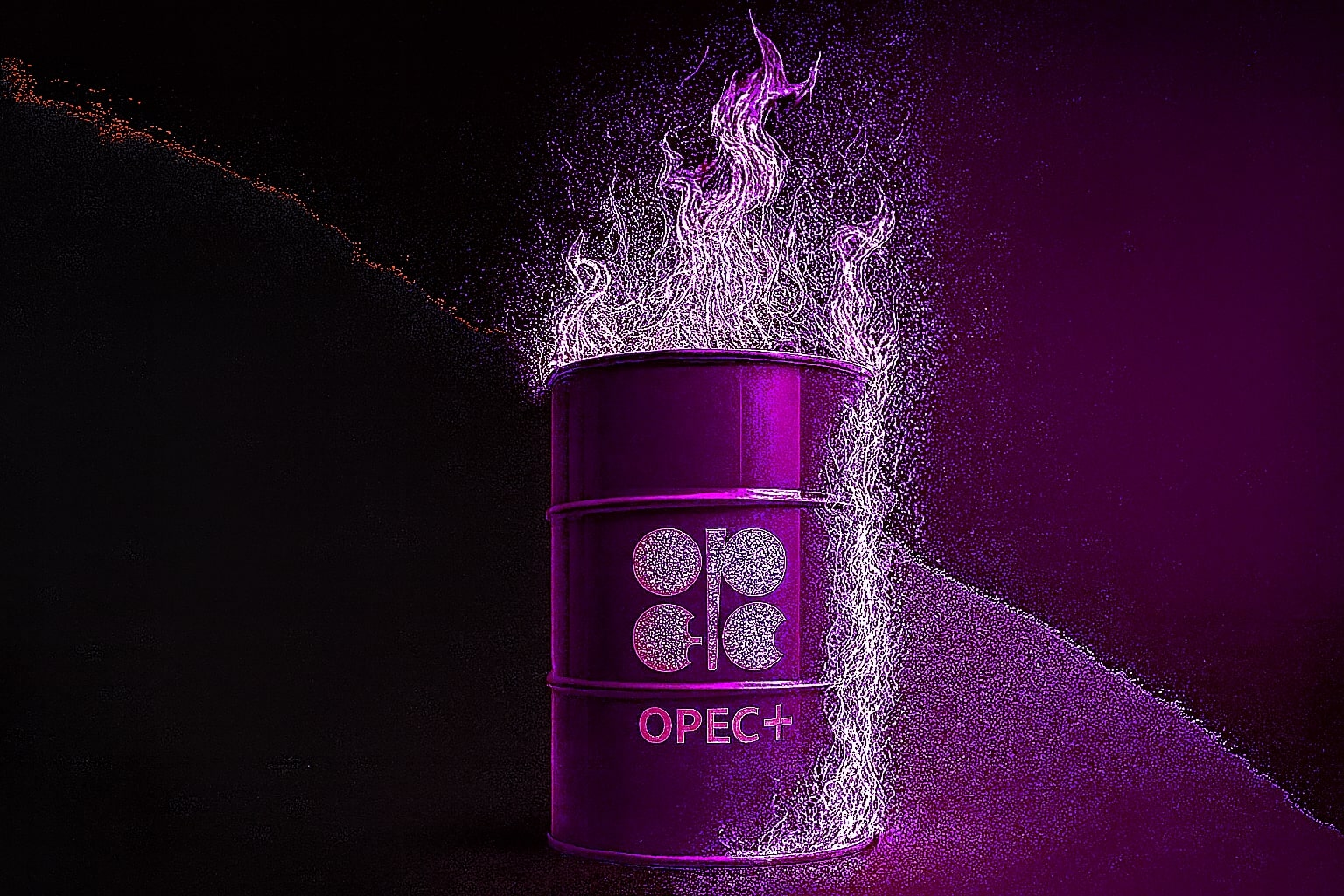
Oil Price Forecast: WTI at $60.07 and Brent at $65.03 as OPEC+ Output Rise and Dollar Rally
Crude oil steadies after steep losses, with OPEC+ poised to boost supply by 137,000 bpd, U.S. production at 13.6M bpd, and China’s factory PMI at 49.0 weighing on demand | That's TradingNEWS
Oil Price Analysis (CL=F, BZ=F): WTI at $60.07 and Brent at $65.03 as Dollar Strength, China Slowdown, and OPEC+ Output Weigh on Market
Crude oil markets are bracing for a third consecutive monthly decline, with WTI crude (CL=F) trading near $60.07 and Brent crude (BZ=F) hovering at $65.03. The combination of a strong U.S. dollar, weak Chinese factory data, and increasing OPEC+ supply has pressured prices into a sustained downtrend. Over October, Brent fell roughly 2.6%, while WTI dropped 2%, marking the steepest three-month slide since early 2023. The global energy complex is now entering a phase of supply abundance, as U.S. production hits 13.6 million barrels per day (bpd) and OPEC+ leans toward a modest output boost in December, according to sources familiar with the group’s discussions.
Macro Pressures: Dollar Rally and China’s PMI Contraction Hit Demand
The U.S. dollar index near a three-month high has made commodities priced in dollars more expensive for foreign buyers, reducing oil demand elasticity. The greenback’s strength stems from Federal Reserve caution after its latest 25-basis-point rate cut, which brought the federal funds rate down to 3.75%–4.00% but was accompanied by Powell’s hawkish statement that another cut in December was “far from a foregone conclusion.” Simultaneously, China’s factory activity contracted for a seventh straight month, with the October PMI dropping to 49.0, missing the forecast of 49.6. This reflects an ongoing slowdown in industrial demand, especially from refiners and heavy industry. Chinese crude imports have fallen to the lowest level since January, reinforcing the view that Asia’s recovery is losing momentum just as supply floods global markets.
OPEC+ Dynamics: Modest Output Boost Ahead of Sunday Meeting
Inside OPEC+, discussions ahead of Sunday’s meeting suggest the alliance may approve a production hike of 137,000 bpd in December. The move comes as member nations attempt to stabilize market share while avoiding an outright price collapse. Saudi Arabia’s exports reached a six-month high of 6.407 million bpd in August, while reports indicate the kingdom may cut its December selling prices for Asian buyers to multi-month lows to retain competitiveness. That price cut, paired with record U.S. shale output and resurgent flows from Russia and Venezuela, paints a picture of sustained oversupply heading into the winter months.
Meanwhile, the U.S. Energy Information Administration (EIA) confirmed that domestic crude output surged to an all-time high of 13.6 million bpd, signaling that American producers are aggressively expanding despite volatile prices. This record production adds downward pressure, especially as inventories swell and futures curves remain in mild contango, implying short-term oversupply relative to future demand.
Geopolitical Undercurrents: Trump’s Tariffs and Energy Diplomacy
President Donald Trump’s renewed tariff regime — including a 100% levy on certain Chinese imports — has complicated the global energy landscape. While Trump announced that China had agreed to “begin purchasing U.S. oil and gas from Alaska,” analysts remain skeptical that such transactions will offset weak industrial demand. The trade tensions, coupled with sanctions pressure on Russian energy exports, have further fragmented trade routes. Despite U.S. sanctions, Russian crude continues to reach China and India, highlighting that price incentives are outweighing diplomatic pressure. ING analysts note that “the market is unconvinced that we will lose a significant amount of Russian oil,” a sentiment reflected in the limited price reaction to new sanctions announcements.
Technical Landscape: Resistance at $62 for WTI and $65 for Brent
WTI prices are consolidating near $60, facing resistance at $62, aligned with the 50-day exponential moving average. A break below $58.50 could trigger deeper losses toward the $57 region, the lowest level since mid-April. The $62–$65 zone has become a clear technical ceiling for both contracts, with fading rallies preferred by traders anticipating more downward drift. Brent, meanwhile, finds resistance around $65.42, followed by a secondary ceiling at $67. Technical charts suggest a gradual descent rather than a sharp collapse, as markets adjust to oversupply rather than panic-selling.
Read More
-
SCHD ETF Price at $27: Can SCHD’s 4% Yield and 9.15% Dividend Growth Beat High-Yield Covered Call ETFs?
15.12.2025 · TradingNEWS ArchiveStocks
-
XRP ETFs Close on $1B Inflows as XRPI at $10.92 and XRPR at $15.52 Hit 52-Week Lows
15.12.2025 · TradingNEWS ArchiveCrypto
-
Natural Gas Price Forecast: NG=F Holds the $4 Floor as Oversupply Clashes with 2026 LNG Demand
15.12.2025 · TradingNEWS ArchiveCommodities
-
USD/JPY Price Forecast - Dollar to Yen At 155: Yen Strength Builds As BoJ Hike And NFP Collide
15.12.2025 · TradingNEWS ArchiveForex
Market Structure and Speculative Positioning
Open interest data shows a 4.7% decline in net long positions among hedge funds over the last week, confirming reduced speculative appetite for crude. The decline aligns with the broader energy rebalancing that started in August, when Brent prices were still above $70. Futures market sentiment has turned defensive, with traders increasingly adopting “fade the rally” strategies on short-term rebounds. In parallel, refinery margins have narrowed as global gasoline demand softens, further discouraging aggressive buying in crude futures.
U.S. Production Surge and Energy Independence Narrative
The return of Trump-era energy policies has played a partial role in boosting domestic output. Since January 2025, the administration has lifted restrictions on drilling in Alaska’s Arctic Refuge, expedited LNG infrastructure approvals, and reopened federal land leases. These steps have accelerated U.S. energy independence efforts but also contributed to the global supply glut. The Dallas Fed’s survey indicates that nearly 75% of U.S. producers report higher drilling costs due to steel tariffs, but output remains resilient thanks to record efficiency in shale operations. Analysts estimate that if oil stabilizes near $60, marginal producers may begin scaling back, potentially setting a floor under the market.
Forecasts: 2025–2026 Outlook Turns Bearish
A Reuters survey projects Brent averaging $67.99 in 2025 and $64.83 for WTI, slightly above previous forecasts but still reflecting subdued optimism. The International Energy Agency (IEA) foresees a 2 million bpd surplus in 2025, potentially widening to 4 million bpd in 2026, with inventories building across OECD economies. Goldman Sachs expects crude prices to remain under pressure through mid-2026, citing excess supply, tepid Chinese demand, and structural weakness in refining margins. For consumers, this downtrend is translating into lower gasoline prices, with the average U.S. pump price dipping below $2.90 per gallon, easing inflationary pressures.
Investor Implications: Oversupply Versus Policy Uncertainty
The market now faces a tug-of-war between free-market production gains and policy-induced headwinds. The removal of climate-oriented restrictions has unleashed U.S. production, yet tariffs and trade uncertainty risk undermining those gains. The OPEC+ meeting outcome will be pivotal for short-term direction — a larger-than-expected output boost could accelerate declines toward $58 for WTI and $63 for Brent, while restraint could stabilize prices near current levels.
Given the current setup, analysts classify crude as bearish but not structurally broken. As long as demand recovery in Asia remains slow and the dollar firm, upside potential appears limited.
Verdict on WTI (CL=F) and Brent (BZ=F)
Oil markets are entering a recalibration phase defined by strong U.S. output, resilient OPEC+ production, and soft Asian demand. The immediate outlook remains bearish, with WTI likely to trade between $58 and $62 and Brent between $63 and $67 through November. Unless OPEC+ signals significant restraint or the dollar weakens, rallies are expected to fade.
Outlook: SELL bias | Range: WTI $58–$62 | Brent $63–$67 | Resistance $65 / $67 | Support $58 / $60.



















